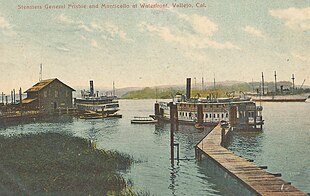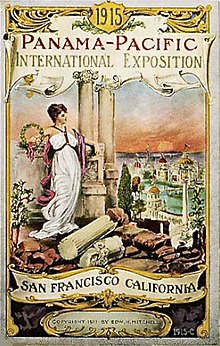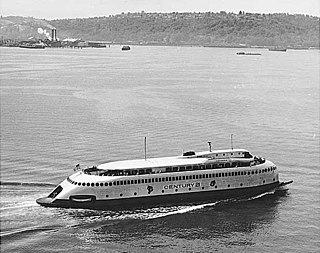
Motor Vessel Kalakala was a ferry that operated on Puget Sound from 1935 until her retirement in 1967.

The Steel Electric-class ferries are a class of auto/passenger ferries that became part of the Washington State Ferry System when Puget Sound Navigation Company was acquired in 1951. They were built in San Francisco Bay for service on Southern Pacific and Northwestern Pacific Railroad routes across the bay.
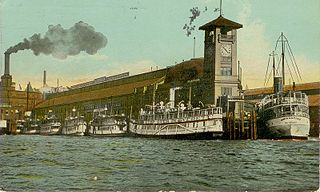
The Puget Sound mosquito fleet was a multitude of private transportation companies running smaller passenger and freight boats on Puget Sound and nearby waterways and rivers. This large group of steamers and sternwheelers plied the waters of Puget Sound, stopping at every waterfront dock. The historical period defining the beginning and end of the mosquito fleet is ambiguous, but the peak of activity occurred between the First and Second World Wars.

Lake Washington steamboats and ferries operated from about 1875 to 1951, transporting passengers, vehicles and freight across Lake Washington, a large lake to the east of Seattle, Washington. Before modern highways and bridges were built, the only means of crossing the lake, other than the traditional canoe or rowboat, was by steamboat, and, later, by ferry. While there was no easily navigable connection to Puget Sound, the Lake Washington Ship Canal now connects Lake Washington to Lake Union, and from there Puget Sound is reached by way of the Hiram M. Chittenden Locks.

The King and Winge Shipbuilding Company was an important maritime concern in the early 1900s on Puget Sound. The shipyard was located at West Seattle. The owners were Thomas J. King (1843–1925) and Albert M Winge. King was born in Boston and learned to build ships under the famous Donald McKay. He came to Puget Sound in about 1880, and worked in the shipyards of Hall Bros. and T.W. Lake before starting his own shipyard with Winge. King’s partner, Albert L. Winge was a native of Norway.

The steamboat Monticello (2) operated in the early 1900s as part of the Puget Sound Mosquito Fleet. The vessel went through several reconstructions and remained in service until 1962, when she was lost in Alaska waters. Her later names were Penaco and Sea Venture. (This Puget Sound steamer should not be confused with the smaller Monticello, which also ran on Puget Sound, but was built in 1895 for Captain Z.J. Hatch of the Monticello Steamship Company.

The steamboat Yosemite operated for almost fifty years on San Francisco Bay, the Sacramento River, inland coastal waters and the lower Fraser River in British Columbia, and Puget Sound.

Asbury Park was a high-speed coastal steamer built in Philadelphia, and intended to transport well-to-do persons from New York to summer homes on the New Jersey shore. This vessel was sold to West Coast interests in 1918, and later converted to an automobile ferry, serving on various routes San Francisco Bay, Puget Sound and British Columbia. This vessel was known by a number of other names, including City of Sacramento, Kahloke, Langdale Queen, and Lady Grace.

Tacoma was a steamship that served from 1913 to 1938 on Puget Sound. Built of steel, Tacoma was known for being one of the fastest and best-designed vessels to operate on Puget Sound. Tacoma was particularly noted for high-speed service from 1913 to 1930 on the route between Tacoma and Seattle.
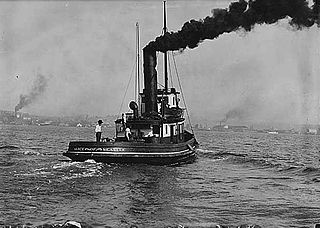
Alice was a Puget Sound steam passenger ship built in 1897. Alice was later rebuilt into a steam tug, and later converted to diesel power and renamed Simon Foss. As a tug, the vessel was in service until 1963. This vessel should not be confused with the similarly designed vessel Alice, built in 1892, which later became Foss 18.

Lady of the Lake was a wooden steamboat that operated on Puget Sound from 1897 to 1903. Following a fire in 1903, the vessel was rebuilt as the tug Ruth.

The City of Seattle was a side-wheel driven steam-powered ferry built in 1888. This vessel was the first ferry to operate on Puget Sound. City of Seattle was also used in the San Francisco Bay area starting in 1913. The ferry was known as YFB54 when owned by the U.S. navy in World War II, and as Magdalena during naval service and for a time following the war. The upper works of the ferry have been mounted on a barge hull, and are now in use as a houseboat in Sausalito, California.
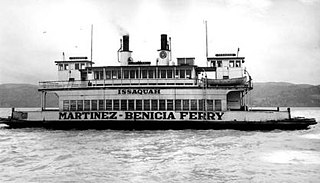
Issaquah was a steam ferry built in 1914 that operated on Lake Washington and in San Francisco Bay.

Carlisle II is the oldest of only two operational examples of a Puget Sound Mosquito Fleet vessel. They were once part of a large fleet of small passenger and freight carrying ships that linked the islands and ports of Puget Sound in Washington state in the late 19th and early 20th centuries.
The MV Willapa was a car ferry that served on the San Francisco Bay and later on Puget Sound. She was one of the Steel Electric-class ferries built in 1927 for service across the San Francisco Bay. Originally named MV Fresno, she was operated by the Southern Pacific Railroad and provided ferry service across the bay.
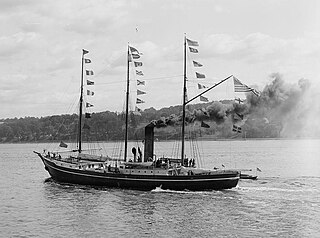
SS Roosevelt was an American steamship of the early 20th century. She was designed and constructed specifically for Robert Peary′s polar exploration expeditions, and she supported the 1908 expedition in which he claimed to have discovered the North Pole.
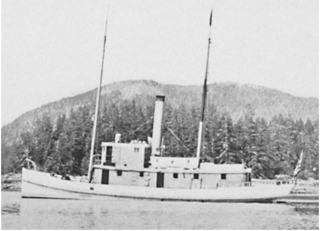
USFS Osprey was an American steamer that served as a fishery patrol vessel in the waters of the Territory of Alaska. She was in commission in the United States Bureau of Fisheries (BOF) from 1913 to 1921, and was the first vessel the BOF ever operated on fishery patrols in Alaska. Before the BOF purchased her, she was the commercial cannery tender Wigwam from 1895 to 1912. After her BOF career ended, she operated as a commercial motor tug with the name Foss No. 19 from 1922 to 1965 and with the name Kiowa from 1965 until she sank in 1978.

Captain John Laurentius Anderson was a preeminent figure in Washington state maritime industries in the first half of the twentieth century, particularly ferry service, shipbuilding, and ship-based tourism. He ran the largest ferry fleet on Lake Washington for three decades. He ran a large ferry fleet in Puget Sound. He built more than a dozen vessels at his shipyards, including the first ocean-going ship ever built on Lake Washington.
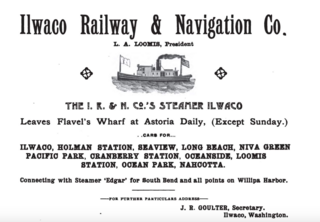
Ilwaco was a small riverine and coastal steamship built in 1890 which was operated as a passenger vessel for the Ilwaco Railway and Navigation Company, and later served in other roles, including tow and freight boat, cannery tender and fish packing vessel. Ilwaco was originally named Suomi.


